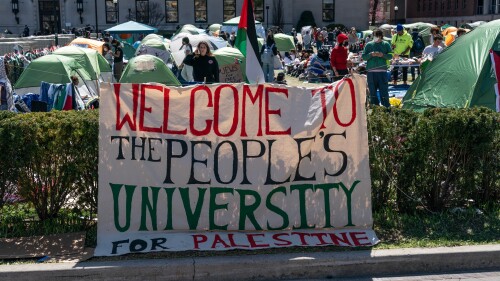As concerns about homegrown terrorism mount, Department of Homeland Security (DHS) officials are increasingly focused on initiatives targeting radicalization in an effort to preempt violence. In congressional testimony in early February, DHS officials touted interagency and “whole government” efforts to counterprogram against radical narratives.1 Such efforts open the door to a complex problem-set that defies traditional policing. A case study on the challenges ahead can be found in Jamaat al-Muslimeen (JaM), an Islamic organization in Baltimore, Maryland with a decades-long track record of extremist rhetoric.
Although JaM explicitly discourages acts of violence by Muslims in the United States, it advances a number of ideological points closely linked to violent radicalism, while excusing virtually all Muslims convicted of terrorism as victims of government persecution. Even with its careful qualification regarding violence in the United States by its adherents, JaM’s message contributes to a permissive environment for violent radicalization by validating core assumptions shared by nearly all homegrown Islamist terrorists.
Background
Headquartered in Baltimore, JaM members hold leadership positions in at least three mosques in the Baltimore area. The organization also has representatives in Tennessee, New York, North Carolina and Pennsylvania.2 Its active membership is estimated to be between 100 and 200 people.
JaM’s primary function is da’wa, or calling Americans to Islam, and supporting Muslims imprisoned in the United States, including a number of convicted terrorists. It also endorses military jihad in Muslim-majority countries and in situations where Muslims are perceived to be under physical attack. This support is mostly rhetorical, but JaM also raises funds for legal costs for the families of Muslims in the United States accused of terrorism.3
Ideologically, JaM is openly critical of American values and morals and supportive of jihad in several theaters overseas, but it repeatedly emphasizes that violent action is not permitted in the United States.4 Islamic thinkers cited by the group include ‘Umar ‘Abd al-Rahman, Ayatollah Khomeini, Abu al-A’la Mawdudi and Sayyid Qutb, with the consistent thread being movement-oriented Islam and a focus on the establishment of Islamic states.5
JaM carries out its da’wa function through personal appearances by group leaders at mosques and conferences around the United States, as well as through an online newsletter called New Trend Magazine, which has been published weekly since the 1970s.
Leadership and Organization
Lincoln University English literature professor Kaukab Siddique is JaM’s leader and the dominant editorial voice of New Trend.7 During the Extrem1970s, Siddique was involved in the publication activities of the Muslim Students Association (MSA)8 and later with its sister organization, the North American Islamic Trust (NAIT), but MSA documents indicate he was fired in 1977 for unspecified reasons.9
Embittered by what he saw—with some justification—as the Saudi government’s use of money to buy religious influence over American Muslim groups, Siddique began publishing a controversial newsletter, New Trend Magazine, around the same time he departed MSA. At some point, his activism congealed into the organization, Jamaat al-Muslimeen.10 JaM’s national leadership is rounded out by a shura council consisting of five members who are located around the United States, including in Brooklyn, Texas, North Carolina and Louisiana.11 The shura members individually take part in both Muslim and minority activism but are less vocal and visible than Siddique. One of the more prominent members, Abdulalim Abdullah Shabazz, is a former member of the Nation of Islam and a distinguished mathematician who received a presidential award for math mentoring in 2000.12
…
JaM’s website states that “jihad is considered a sixth pillar [of Islam] in countries where Islam is the majority religion.” In its preaching and in the newsletter, the organization has repeatedly supported armed struggle in overseas theaters commonly associated with Islamist terrorism and extremism.14
…
Despite its celebration of military jihad opposing American “occupations” abroad, Siddique clearly and repeatedly advises readers of New Trend that they cannot undertake violence against Americans in the United States, where Muslims are a minority:
In America, Muslims have the duty of peacefully giving the message of Islam. The jihad with the sword is not applicable to a Muslim minority living in a non-Muslim country. Jihad with weapons is appropriate where Muslims are being physically attacked.19
JaM clearly defines jihad primarily as armed struggle and explicitly refutes arguments by mainstream U.S. Muslim leaders in favor of a non-violent definition prioritizing the spiritual struggle against temptation and wrongdoing:
The fact is that Islam teaches Jihad as ARMED STRUGGLE against oppressors. The verses of the Qur’an and the teachings of the Prophet Muhammad (pbuh), make it absolutely clear that JIHAD MEANS ARMED STRUGGLE AGAINST OPPRESSORS, OCCUPIERS, TYRANTS. Many in the Muslim world consider America and Israel, along with India and Russia, as oppressors and exploiters who should be fought. The idea that Jihad is a peaceful, inner, spiritual development is absurd and without foundation.21
…
Because its message is so carefully crafted and controlled, JaM presents a challenging target for traditional law enforcement and counterterrorism techniques. JaM’s strong stand against mainstream Muslim “collaborators” also makes it a highly unlikely partner for the sort of community-based outreach that DHS hopes to use in its counterradicalization efforts. Other radicalizing organizations, including those more closely tied to violence, are already learning to adapt by adopting an approach similar to the strategy that has kept JaM viable and operating in plain sight for decades.



